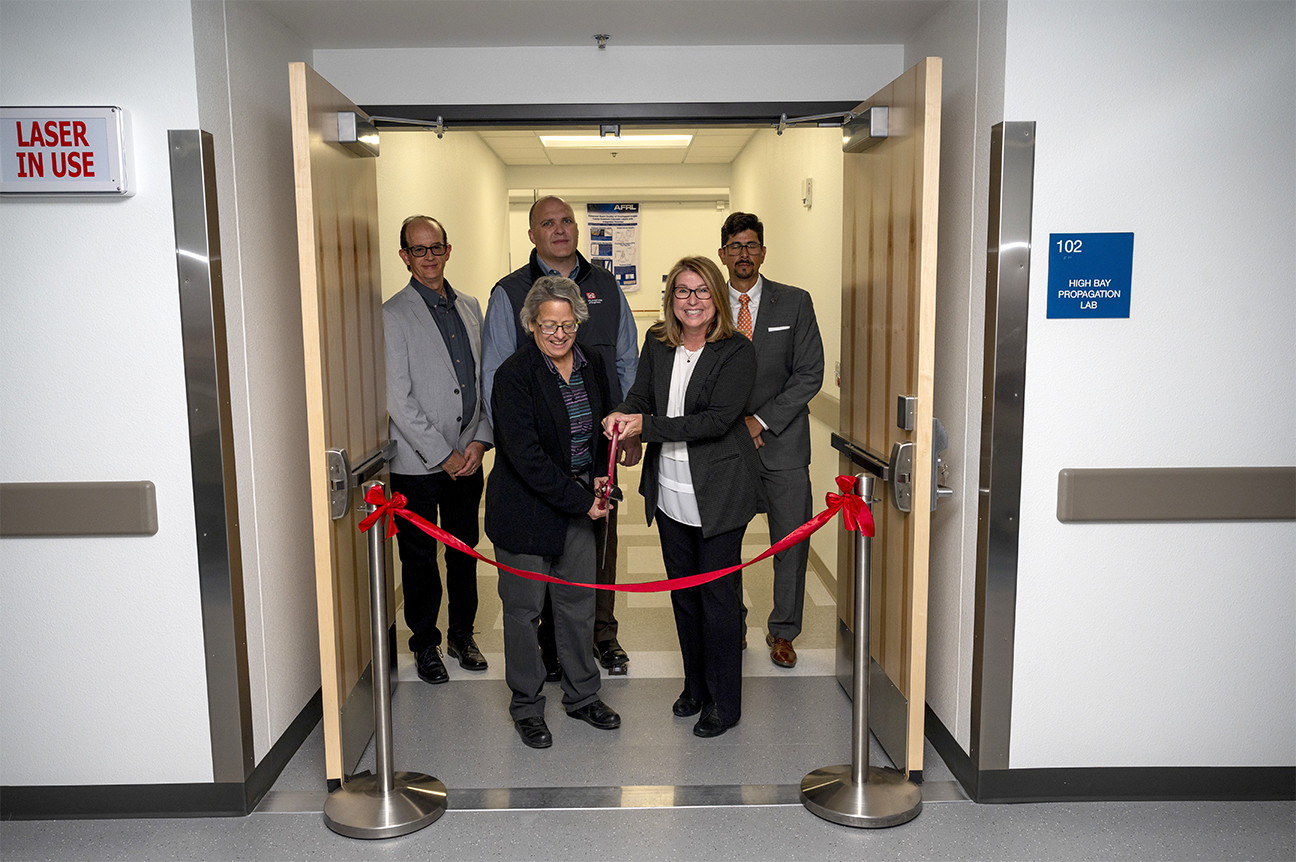Ribbon cutting for world-class laboratory at AFRL resides in NM
KIRTLAND AFB, N.M. (AFRL) – The Air Force Research Laboratory, or AFRL, held a ribbon-cutting ceremony Oct. 17, 2023, at Kirtland Air Force Base, to mark the opening of the new Semiconductor Laser Indoor Propagation Range, or SLIPR. This 17,158-square-foot addition consists of a 3,500-square-foot high bay propagation lab.

Dr. Shery Welsh, front right, Air Force Laboratory directed energy directorate director, and Dr. Imelda Atencio, front left, AFRL’s directed energy laser division chief, prepare to conduct a ribbon cutting ceremony in celebration of the new Semiconductor Laser Indoor Propagation Range on Kirtland Air Force Base, N.M., Oct. 17, 2023. The range will serve to further aid AFRL in the research and development of propagation studies to fill in critical technology gaps. (U.S. Air Force photo / Airman 1st Class Ruben Garibay)
The approximately $7.2 million project will enable future laser system propagation studies in support of technology innovation and improve in-house research capabilities to address critical technology gaps. SLIPR provides 100-meter-long broadcast ranges in an indoor facility to test concepts. SLIPR’s two specialized labs include the photoluminescence and the X-ray labs, which will be used to characterize materials grown by molecular beam epitaxy a process used to make semiconductor devices. AFRL creates diode lasers, a type of semiconductor that emits radiation at infrared wavelengths. In the past, to get these indoor ranges, researchers had to travel to use facilities outside of the state.

Matthew Suttinger, left, Air Force Laboratory directed energy acting principal investigator, briefs members and supporters of the Air Force Laboratory about the work in the Semiconductor Laser Indoor Propagation Range at Kirtland Air Force Base, N.M., Oct. 17, 2023. AFRL conducted a ribbon cutting ceremony for their new laser range that will serve to aid in propagations studies to fill in critical technology gaps. (U.S. Air Force photo / Airman 1st Class Ruben Garibay)
“Within the technologies branch, we have three programs: the laser effectors, laser beam control and laser illuminators,” said Dr. Imelda Atencio, AFRL Directed Energy Laser division chief. “The laser illuminator group is currently developing laser sources from the 1–10-micron wavelength region and expertise and equipment in laser design, growth, processing, fabrication and characterization that will allow them to make specifically designed illuminator lasers that can be delivered to the warfighter.”
AFRL’s laser division also supports Special Operations Command by delivering hundreds of fabricated laser devices that will be tested in the SLIPR. This effort represents yet another transition of laser technology from the laser division.
“World-class personnel need world-class facilities,” said Dr. Shery Welsh, director of AFRL’s Directed Energy Directorate. “It is the way the Directed Energy Directorate is going to maintain our vibrant in-house research capability. We have the nation’s most innovative people working at the Air Force Research Laboratory and this state-of-the-art facility will allow us to maintain our agility.”
“The mission of the laser division is to discover, develop and deliver advanced laser technology capability to the Department of the Air Force, components across the Department of Defense and most importantly, the warfighter,” Welsh said. “We do this for the warfighter. We want to ensure they have cutting edge technology at their fingertips to provide technological surprise on the battlefield for our strategic competition.”

Members and supporters of the Air Force Laboratory directed energy directorate pose for a group photo after the ribbon cutting of the new Semiconductor Laser Indoor Propagation Range on Kirtland Air Force Base, N.M., Oct. 17, 2023. The range will serve to further aid AFRL in the research and development of propagation studies to fill in critical technology gaps. (U.S. Air Force photo / Airman 1st Class Ruben Garibay)
About AFRL
The Air Force Research Laboratory, or AFRL, is the primary scientific research and development center for the Department of the Air Force. AFRL plays an integral role in leading the discovery, development and integration of affordable warfighting technologies for our air, space and cyberspace force. With a workforce of more than 12,500 across nine technology areas and 40 other operations across the globe, AFRL provides a diverse portfolio of science and technology ranging from fundamental to advanced research and technology development. For more information, visit www.afresearchlab.com.
